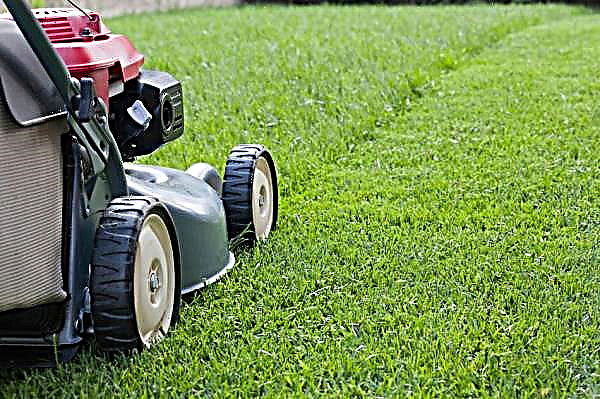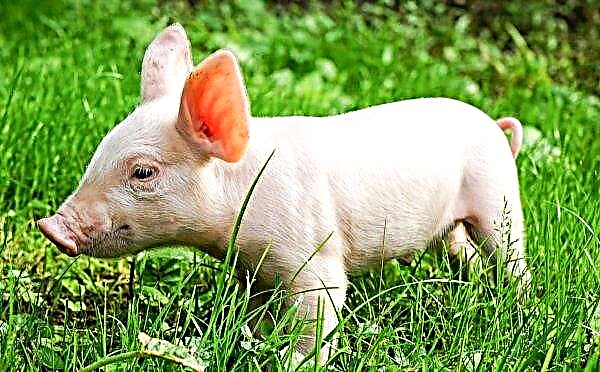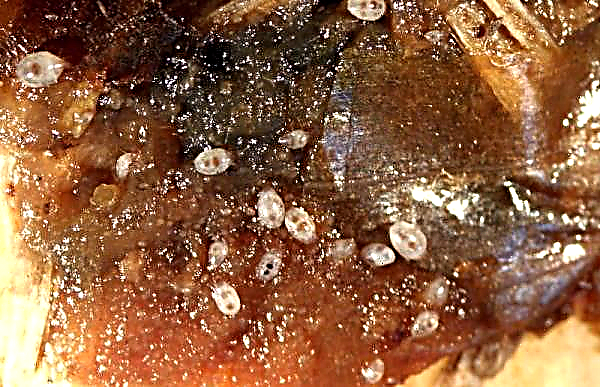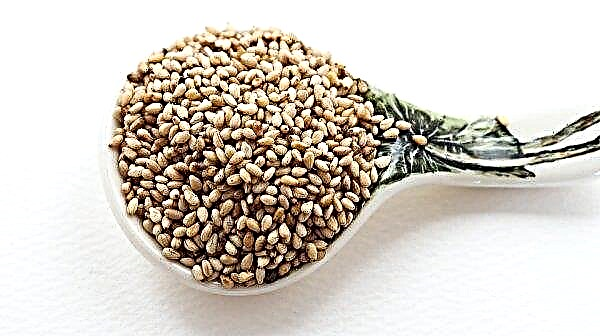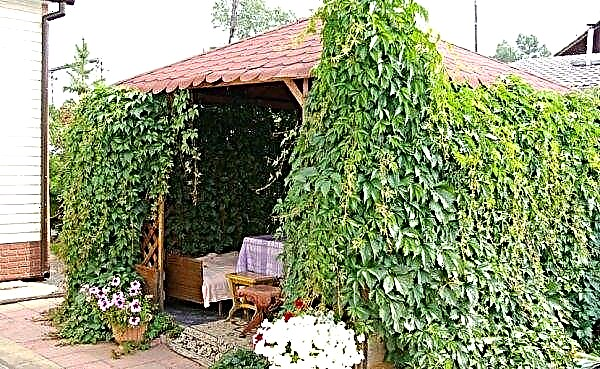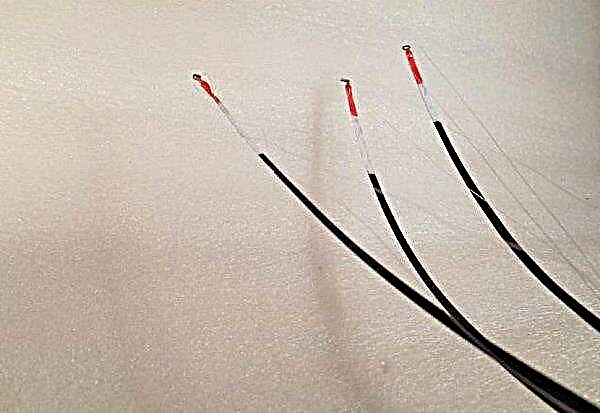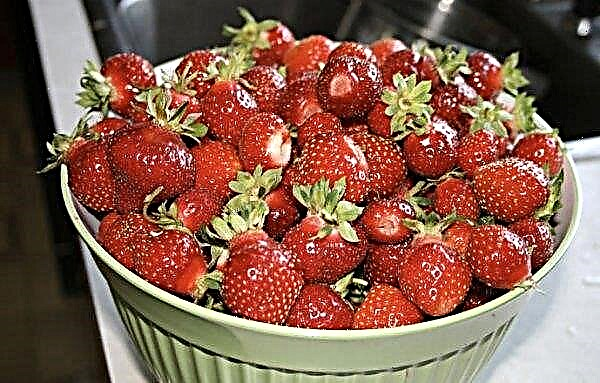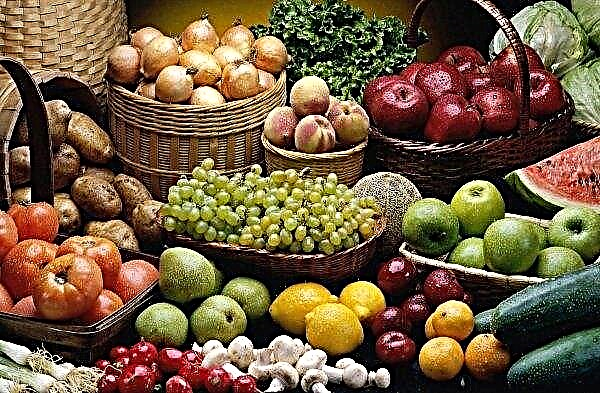Thuja Yantar is considered one of the best ornamental plants that are used in landscaping and garden plots. Unpretentiousness in leaving, simplicity in cultivation and ability to keep decorativeness all year round distinguishes culture from other representatives of conifers. What are the features of planting and cultivating a tree, and how it is used in landscape design - find out from the article.
Botanical Description
Thuja western Amber (Jantar) is an evergreen coniferous tree, which is the result of the selection of the Polish geneticist Jakub Jablonski. From its genetic basis - thuja western Smaragd, Amber received high decorativeness, an almost perfect crown shape and unpretentiousness to environmental conditions. A peculiarity of the plant is considered to be a surprisingly beautiful yellow color of needles, which in winter acquires an amber-sunny hue.
A peculiarity of the plant is considered to be a surprisingly beautiful yellow color of needles, which in winter acquires an amber-sunny hue.
The description of the tree is advisable to start with its appearance. Thuja belongs to plants with medium growth rates and in adulthood is able to reach a height of 3–5 m. Annual growth is 15–30 cm. The crown of the tree is regular, narrow-conical, dense, formed by numerous densely located, branched branches with yellow scaly needles.
The shoots and bark of the tree are decorated with dark brown or reddish bark, which exfoliates with long narrow stripes. The root system of the arborvitae is characterized by branching, has 2-3 deep processes, but in general, is close to the surface.Did you know? Thuja wood is considered a very valuable material, because, due to the high resin content, it does not lend itself to decay. Expensive musical instruments, furniture and decor items are made from it.
 The fruits of the culture are presented in the form of small cones, a length of not more than 1.2 cm, appearing in small quantities on the branches of the side branches.
The fruits of the culture are presented in the form of small cones, a length of not more than 1.2 cm, appearing in small quantities on the branches of the side branches.
Immature cones are yellow-green, and in the process of maturation they acquire a brown color. Thuja seeds are small, narrow, winged.
The thuja of the described variety has high frost resistance (up to –36 ° C), is not capricious in the care and cultivation, is able to adapt perfectly in urban conditions, which makes it possible to use it to decorate gardens, parks, personal plots, as well as in landscape design.
Use in landscape design
Due to the extremely beautiful color of needles and unpretentiousness to environmental conditions, thuja Yantar is one of the favorites used in landscape design. In a group of other green park or garden crops, it creates a bright accent, harmoniously complements and refreshes container compositions. The tree looks good in the company with different plants, and is also suitable for a single planting.

Hedge
One of the most common methods of using thuja is the creation of hedges. Throughout the whole year, Amber is able to delight with the original yellow outfit.
In landscape design, there are two forms of hedges:
- sheared;
- free growing.

The tree of the described variety looks better in a freely growing hedge, because it has not too large dimensions, a dense crown that does not close when growing with a number of growing thuja. When arranging hedges, a plant is planted in one or two rows.
Songs
Thuja Yantar is characterized by an elegant, highly decorative look, excellent frost resistance, ease of care and good adaptation to climatic conditions. Such properties contribute to the fact that designers use culture to create original decorative compositions.
It looks great between shrubs, ornamental perennial crops, climbing vines and deciduous plants. Often the thuja of the described variety, thanks to the unusual color of the crown, make rock gardens as a bright color accent.
Topiary pruning
The thuja amber is a real find for topiary art. The shoots of the plant lend themselves well to pruning and shaping, which allows you to create unusual, unique figures from a tree, with which you can turn a simple garden into an exclusive dendrological park.
It will certainly be difficult to create complex, multi-level and voluminous figures from a thuja to a beginning gardener. In addition to the fact that such topiary trimming requires skills and experience, it implies the use of special metal frames.Did you know? Thuja western has a delicate pleasant aroma. The thing is that the wood and leaves of the plant contain essential oils, which are widely used in perfumery and cosmetology.
But to make simple neat figures in the form of a regular cone or spirals is possible for anyone, the main thing is that you don’t need to “mock” the plant and radically change its natural shape.
Landing rules
Planting Amber does not cause much difficulty for gardeners. However, for a plant to enjoy high decorativeness for a long period, when carrying out planting, it is necessary to adhere to several important rules.
Before you land a thuja on a site, you need to choose a comfortable place for it. The tree belongs to the category of photophilous, therefore, prefers to grow in well-lit, sunny areas, reliably protected from cold winds and drafts. The plant is able to grow in partial shade, however, under such conditions, it loses its decorativeness and bright color of needles.Important! You can not plant thuja Amber in lowlands or areas with a close location of groundwater, as this can provoke decay of the root system.
 When planting thuja on heavy soils, it is necessary to organize a drainage layer at the bottom of the landing pit, which will prevent stagnation of water in the soil.
When planting thuja on heavy soils, it is necessary to organize a drainage layer at the bottom of the landing pit, which will prevent stagnation of water in the soil.
Particular attention is recommended to be paid to the choice of soil on which the crop will be planted. Amber responds well to light, moisture-permeable, peat or clay lands, with a moderate amount of nutrients.
The good development of the arborvitae and its high aesthetic properties largely depend on the quality of the planting material.
 Amber can be planted in open soil both in early spring and in autumn in September.
Amber can be planted in open soil both in early spring and in autumn in September.
Therefore, when choosing a seedling, you should pay attention to several aspects:
- Root system. It is better to give preference to closed roots with a moist earthy coma. The bare root processes can suffer during transportation of the plant, as a result of which it does not take root.
- Crohn and trunk. These parts of the plant should not show signs of rot, damage or any disease.
- Needles. In healthy specimens, the needles should be fresh, keep tight on the shoots. Dry and falling needles testifies to the old age and unsuitability of planting material.
The planting technology is traditional and practically no different from the procedure for planting other conifers:
- dig a recess with a depth of at least 80 cm;
- at the bottom of the pit, line a drainage layer, about 15 cm, of broken brick, expanded clay or pebbles;
- part of the seized soil mixed with sand, peat and sod land, in a ratio of 1: 1: 2;
- fill the fertile soil in the recess;
- Place the seedling in the pit, fill it with the remaining mixture so that the neck of the root remains on the surface by 6-8 cm;
- Tamp the soil around the tree lightly, pour plenty of water on the trunk circle with well-maintained water.
 To organize a hedge, culture is planted in one or more rows. In single-row planting between specimens, a distance of 0.4–0.5 m is maintained; when planting in several rows, 0.5–0.7 m is maintained.
To organize a hedge, culture is planted in one or more rows. In single-row planting between specimens, a distance of 0.4–0.5 m is maintained; when planting in several rows, 0.5–0.7 m is maintained.Care Features
Thuja of the described variety is appreciated by gardeners, primarily because of its unpretentiousness in care. However, to obtain a strong, aesthetically beautiful tree during plant cultivation, a number of basic agrotechnical techniques should be performed.
Watering and feeding
The culture prefers moderate hydration, which is carried out as the topsoil dries up, approximately 1-2 times a week, with a dry summer - every other day. An adult plant needs 10 liters of standing water; young specimens need only 1/3 or 1/2 bucket, depending on age and height.
Thuja responds well to sprinkling, which is carried out in the evening, several times a month. They feed the culture once a season - in early spring. As fertilizers, they use instant complexes specially designed for coniferous crops. It is allowed at the end of the growing season to nourish thawed with potash, which strengthen the immunity of the tree, increase its resistance to ailments and parasites.
Soil mulching
Mulching helps to prevent soil drying in the hot summer period. It is carried out by means of natural materials - sawdust, dry grass, spruce branches, which are placed in the area of the trunk circle.
In addition to preserving moisture, mulching allows you to:
- protect root shoots from freezing in the winter;
- create a favorable atmosphere for intensive growth and development of roots.
Important! Before trimming, all tools must be sanitized without the need to introduce infection into the sections.
Trimming and Shaping
To thuja Yantar had a neat, attractive appearance, gardeners in early spring carry out shaping and sanitary pruning. In the course of the latter, old, sick, dry, too weak and thickening crown branches are removed. The plant responds well to the haircut, allows you to form a crown of almost any shape.
Disease and Pest Prevention
Thuja western Amber has good immunity, however, if the rules for caring for it and adverse climatic conditions are not observed, it can suffer from fungal ailments and pests.
Of the latter, the greatest danger to culture are:- thuja aphid;
- false shield;
- bark beetle;
- spider mite.

These parasites cause serious damage to the culture, provoke yellowing of the needles, its drying out and further decay. To protect the plant, in the spring they carry out spraying with solutions of modern insecticidal preparations, for example, Aktara, Aktellik.
Of the diseases, thuja is most susceptible to fusarium, shute and cytosporosis. Treating the plant with a solution of Bordeaux liquid, as well as the antifungal fungicidal agents that spray the tree in the spring, with an interval of two weeks, helps to reduce the risk of infection with the described ailments.
Thuja Yantar is one of the best decorative representatives of conifers, a feature of which is considered undemanding in cultivation and the ability to maintain a magnificent appearance throughout the year. Having organized basic care for the plant, even an inexperienced gardener can grow a stunning tree in his garden.

